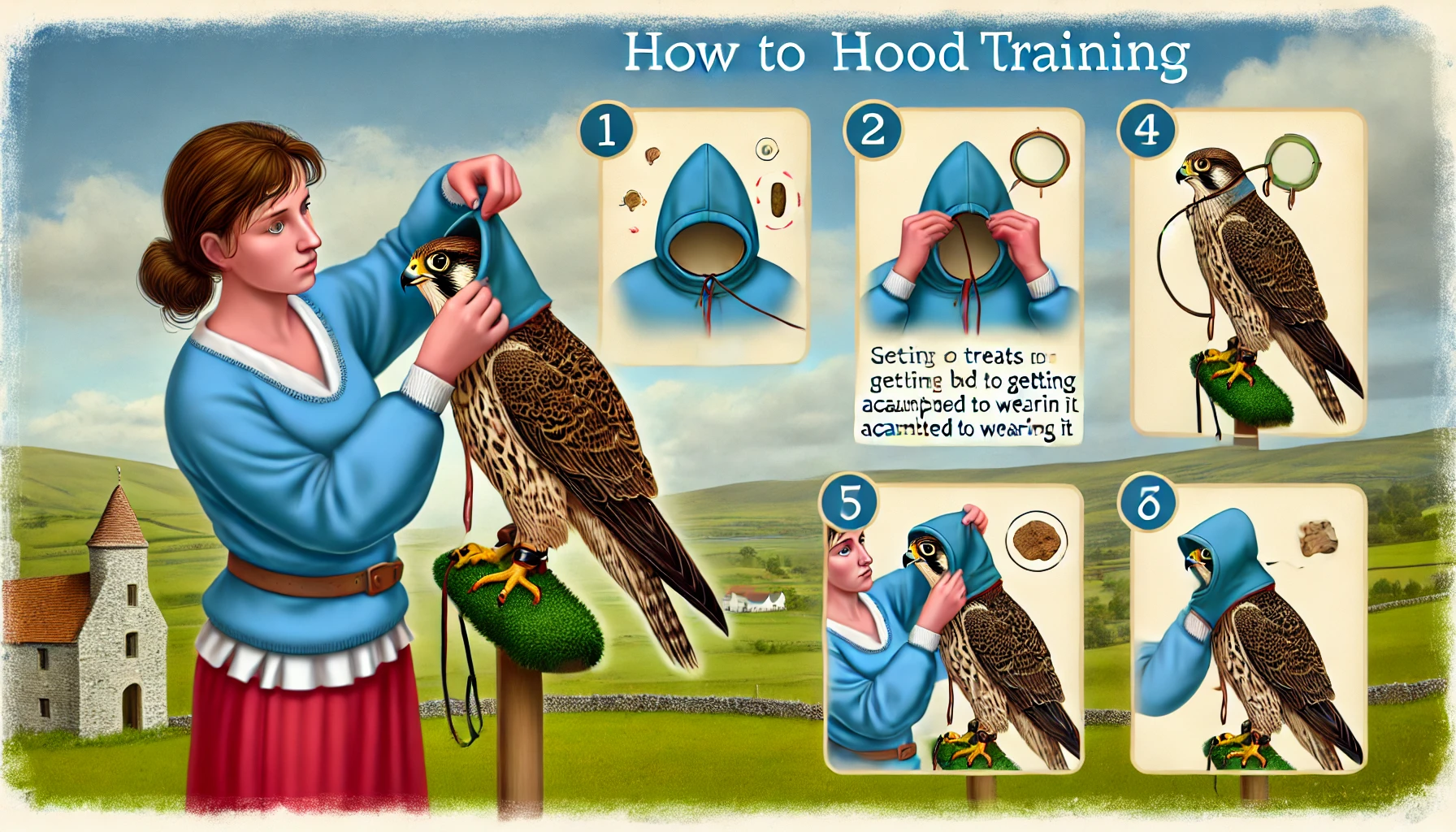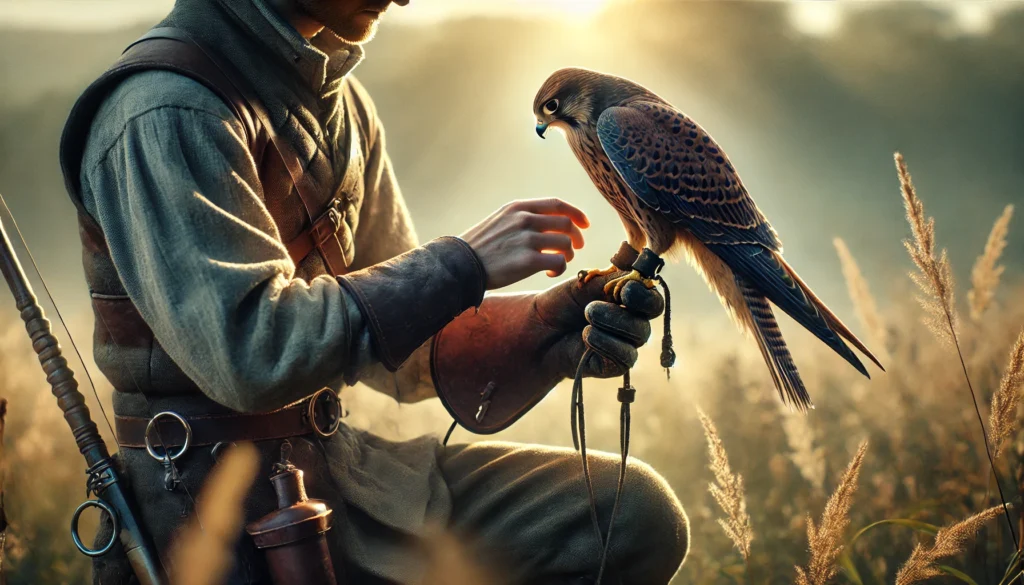Essential Hood Training Techniques
Introduction to Hood Training
- Training a falcon to wear a hood is essential for managing the bird.
- The hood keeps the falcon calm and focused.
Choosing the Right Hood
- Ensure the hood fits properly to avoid discomfort.
- A good hood should cover the eyes completely but allow for easy breathing.
Step-by-Step Hood Training Process
- Start by introducing the hood gradually.
- Use gentle and reassuring methods to place the hood on the falcon.
- Reward the falcon with treats to create positive associations.
Handling the Hooded Falcon
- Regularly handle your falcon while it’s hooded to get it accustomed.
- Pay attention to the falcon’s reactions and adjust techniques if needed.
Consistency and Patience
- Training should be done consistently but without rushing.
- Patience is key; every falcon will adjust at its own pace.
Signs of Successful Hood Training
- A well-trained falcon remains calm when hooded.
- The falcon associates the hood with positive experiences like feeding or resting.
By following these techniques, you’ll effectively train your falcon, ensuring both comfort and cooperation.
Mastering Hood Training Techniques in Falconry: A Journey Worth Taking
Welcome to the whimsical world of falconry, where mastering the art of hood training opens up a timeless bond between falconer and bird. Imagine you’re on a scenic walk across the rolling green hills of Ireland. You come across a shepherd skillfully guiding his flock with the aid of a loyal sheepdog. Just as the shepherd and his dog perform a graceful dance of control and harmony, the relationship between falconer and bird hinges on crucial training techniques’like hood training!
At Learn Falconry, we believe that understanding these techniques is essential for bonding with your feathered friend and ensuring both their safety and effectiveness in the sport. In this article, we will dive deep into the techniques of hood training, guiding you step-by-step through the methods that transform a wild raptor into a cooperative partner.
So why is this important? Well, just like our Irish shepherd, you want to effectively guide and communicate with your avian companion. By mastering hood training, you’re setting the foundation for a trusting relationship that ensures your bird’s comfort and performance. It’s a journey filled with delicate nuances and profound rewards, making it well worth your time to keep reading.
Join us as we explore the intricate art of hood training, and unlock the secrets that every falconer should know. This isn’t just about technique; it’s about building a lifelong connection with your bird. Let’s embark on this exciting journey together!
Training falcons requires patience, precision, and a good understanding of various techniques. Among these, mastering falcon hood techniques is essential. Hood training is a skillful method that helps in keeping a falcon calm and relaxed, especially during transport or while being handled. So, let’s dive into the fascinating world of hooding your falcon!
Understanding the Falcon Hood Techniques
Falcon hood techniques have been used for centuries as part of traditional falconry. The hood is a small leather cap that covers the bird’s eyes and helps in controlling its vision. This makes the falcon more manageable and less stressed during different situations.
If you want to learn about the historical background of falconry and how these techniques have evolved over time, be sure to check out our article on The History of Falconry.
Hood Methods: A Step-by-Step Guide
Learning how to put a hood on a falcon can be a bit tricky at first, but with practice, you’ll get the hang of it. Here’s a step-by-step guide to help you through the process:
- Choosing the Right Hood: It’s important to pick the correct size and type of hood for your falcon. You can explore different types of hoods on our page about Falconry Equipment.
- Familiarize the Falcon with the Hood: Before you start hooding, allow your falcon to inspect and get used to the hood. Gently introduce it by holding it close to the falcon without trying to put it on immediately.
- Calm Your Falcon: Ensure that the falcon is calm and comfortable. Sometimes, falconers use techniques like manning or conditioning to help the bird get used to being handled. For more on this, visit Training a Falcon.
- Gently Place the Hood: Hold the falcon securely on your gloved hand. With the other hand, carefully place the hood over the falcon’s eyes and fasten it.
- Adjust and Secure: Make sure the hood fits snugly but comfortably. The falcon shouldn’t be able to shake it off, but it also shouldn’t be too tight as to cause discomfort.
- Practice Regularly: Practice makes perfect. Frequently hood and unhood your falcon until it becomes a routine for both you and your bird.
Why Hood Training is Important
Hood training is crucial for several reasons. It significantly reduces stress for the falcon, allowing the bird to remain calm in unfamiliar or potentially stressful situations. Moreover, it aids in safe transportation and ensures the falcon’s wellbeing.
For more insights on specific training techniques tailored to different species, visit Training Different Species.
Additionally, understanding the proper use of falconry equipment, including hoods, gloves, and telemetry, enhances your overall falconry experience. Learn more about the essential gear in our Falconry Equipment section.
Tips for Successful Hood Training
- Be patient and gentle. Rushing the process can cause unnecessary stress.
- Ensure the hood is of good quality and well-maintained.
- Regularly check the falcon for any signs of discomfort or stress while hooded.
After mastering hooding, you can move on to mastering other falconry techniques. Explore more about falconry techniques and advanced training methods here.
Remember, successful hood training builds a solid foundation for your journey in falconry. With patience, practice, and perseverance, you’ll develop a strong bond with your falcon while ensuring its comfort and safety. Check out our Falconry for Beginners for more tips and guides.
Let’s get started on this incredible journey into the art of falconry. Happy hooding!
How to Properly Use Hood Training Techniques for Falcons
Measuring the Hood
Before you begin hood training, it’s super important to measure your falcon’s head accurately! Take a look at your bird from above and measure across the widest part. For instance, a big female Red-Tail or Gyrfalcon might have a head width of about 2.5 inches. Accurate measurements ensure the hood fits well, which keeps your bird comfy and safe.
Adjusting the Fit
Next up, adjusting the fit! Look for any signs around the eyes. If there’s any weeping, loosen the straps because the fit might be too tight. Make sure the beak opening lets the falcon breathe and cast comfortably. Adjust the chin strap and back closure so no feathers get caught and the hood doesn’t press hard on the head.
Ensuring the Right Eye Clearance
Eye clearance is key! The hood shouldn’t irritate your bird’s eyes. You can always tweak the beak opening later if needed.
Using an Adjustable Chin Strap
An adjustable chin strap, especially one that’s dropped or angled, can make a huge difference. It offers more room around the beak and can be easily adjusted by you. This flexibility helps in achieving a perfect fit.
Monitoring Bird Comfort
You should always keep an eye on your bird’s comfort. Leave the hood on for an hour or two and then check it. Ideally, the feathers should be smooth and not ruffled when you remove the hood. Remember, the best-fitting hood won’t leave feathers looking squished or molded.
Turk’s Head Knot and Alternatives
The top knot, traditionally known as a Turk’s head knot, helps seat the hood snugly on your hawk’s head. But you can get creative! Some falconers use beads, horsehair, or even feathers. These materials can help keep the hood in place and also make it easier to open.
Proper Hood Removal
Lastly, removing the hood correctly is essential. Push back on the top knot to seat the hood well, then push forward to open the braces. This method will help you remove the hood smoothly without disturbing your bird much.
Hood Measurement and Fit Table
| Falcon Type | Head Width (Inches) | Ideal Hood Fit |
|---|---|---|
| Large Female Red-Tail | 2.5 | No eye weeping, smooth feathers |
| Gyrfalcon | 2.5 | No eye weeping, smooth feathers |
By following these steps, you make sure your falcon’s hood fits just right, keeping your bird both comfortable and happy. Happy hood training from Learn Falconry!
Mastering Hood Training Techniques for Your Falcon
Hood training is a fundamental skill that ensures the comfort and safety of your falcon. Here are the key techniques to master:
- Measure the Hood Precisely: Careful measurement of your falcon’s head ensures a snug and comfortable fit, especially for larger species like the Red-Tail or Gyrfalcon.
- Adjust for Perfect Fit: Pay attention to signs like weeping around the eyes to ensure the hood fits well. Adjust the chin strap and back closure to prevent discomfort or feather damage.
- Ensure Proper Eye and Beak Clearance: Adequate eye clearance prevents irritation, while adjustable chin straps allow for fine-tuning around the beak.
- Monitor Your Bird’s Comfort: Leave the hood on for a short while to check for any uncomfortable fit. Ideal hoods leave feathers intact and unruffled.
- Use the Right Knot: A well-chosen top knot helps seat the hood correctly and makes it easier to put on and remove.
- Proper Removal Technique: Push back to seat the hood and forward for a smooth removal, ensuring your bird remains unbothered.
These steps will help you become proficient in hood training, promoting the well-being of your falcon while strengthening the bond between you and your majestic bird. Happy falconry!



